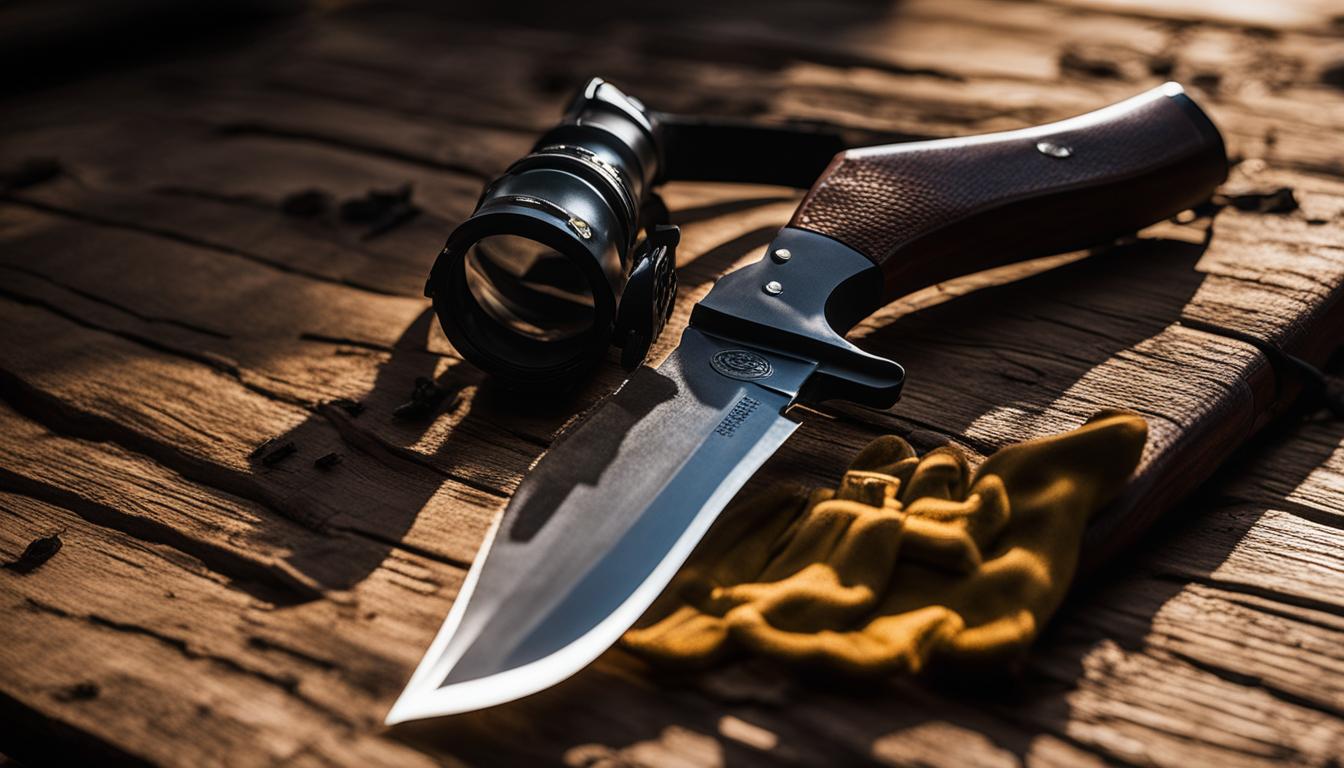When it comes to choosing a hunting knife, two factors stand out as crucial: blade length and safety features. Let’s delve into why these aspects are vital in selecting the perfect hunting knife.
- Blade length should be suitable for the tasks at hand, with a recommended range of 3 to 5 inches for general hunting purposes.
- Longer blades are better suited for larger game, while shorter blades offer versatility for various tasks.
- Prioritize safety by choosing a knife with a secure grip handle and a sheath that allows for safe storage and easy access.
Blade Material and Style
When choosing a hunting knife, it’s essential to consider the blade material and style. These factors play a crucial role in the knife’s performance and functionality. The blade material determines its durability, sharpness, and resistance to corrosion, while the style determines its versatility for different tasks. Let’s explore the different blade materials and styles commonly found in hunting knives.
Blade Material
There are two main types of blade materials used in hunting knives: stainless steel and high-carbon steel. Stainless steel blades are known for their corrosion resistance, making them suitable for hunting in wet or humid conditions. They require less maintenance and are less prone to rust. On the other hand, high-carbon steel blades offer excellent edge retention, making them ideal for tasks that require sharpness and precision. They are harder and can maintain their edge longer than stainless steel blades, but they are more prone to rust and require regular maintenance.
Blade Style
Hunting knives come in various blade styles, each designed for specific purposes. The most common blade styles include:
- Drop Point: This style features a curved blade with a lowered point, making it versatile for different tasks such as skinning, slicing, and general-purpose cutting. It provides excellent control and is suitable for most hunting situations.
- Clip Point: The clip point blade has a concave cut-out near the spine, leading to a finer and sharper point. It offers enhanced precision and is ideal for piercing and detailed work. However, it may be more prone to breaking under heavy use compared to other blade styles.
- Gut Hook: Some hunting knives feature a gut hook on the spine. This specialized blade style is designed for field dressing game without piercing internal organs. The gut hook allows hunters to make precise incisions while minimizing the risk of accidental damage.
When choosing a blade style, consider the specific tasks you’ll be performing during your hunting expeditions. The drop point blade offers versatility for a range of tasks, the clip point excels in precision work, and the gut hook is ideal for field dressing big game.
| Blade Material | Pros | Cons |
|---|---|---|
| Stainless Steel | Corrosion resistance Low maintenance |
Less edge retention Potential for rust |
| High-Carbon Steel | Excellent edge retention Sharpness and precision |
Prone to rust Requires regular maintenance |
Understanding the different blade materials and styles is crucial in making an informed decision when choosing a hunting knife. Consider your hunting environment, personal preferences, and specific tasks to ensure you select a knife that meets your needs and enhances your hunting experience.
Handle Material and Blade Design
When selecting a hunting knife, two crucial factors to consider are the handle material and blade design. A well-designed handle with a suitable material provides a comfortable and secure grip, ensuring optimal control and reducing the risk of accidents. Different handle materials offer unique advantages, and the choice ultimately depends on individual preferences and hunting conditions.
Common handle materials for hunting knives include wood, rubber, and synthetic materials like G10 and Micarta. Wood handles, such as those made from walnut or birch, not only provide a classic, visually appealing aesthetic but also offer a natural warmth and feel. However, they may require more maintenance and are not as resistant to the elements as other materials.
In contrast, rubber handles and synthetic materials like G10 and Micarta offer superior grip and durability. These materials provide a secure grasp even in wet or cold conditions, ensuring a firm hold on the knife during use. Additionally, rubber handles offer shock absorption, reducing hand fatigue during prolonged use. Synthetic handle materials are often lightweight, making them an excellent choice for those who prioritize portability.
Blade Design
Blade design is another important consideration when choosing a hunting knife. Different blade designs are optimized for specific tasks, ensuring efficient performance in various hunting scenarios. For example:
- Drop Point Blades: These blades are versatile and well-suited for skinning, slicing, and general-purpose use. The broad, curved shape makes them ideal for controlled cutting and minimizing the risk of accidental punctures.
- Clip Point Blades: Known for their thin, sharp tips and concave shape, clip point blades are excellent for precision work. They are particularly useful when detailed cutting or piercing is required.
- Skinner Blades: Skinner blades are specifically designed for effective flesh-to-skin separation during field dressing. These blades feature a curved, sweeping edge that facilitates smooth, efficient skinning of game without damaging the underlying meat.
Some hunting knives also come with gut hooks, which are small, sharpened notches on the back of the blade. Gut hooks allow for quick and clean field dressing of large game without the risk of piercing internal organs unintentionally.
| Handle Material | Advantages |
|---|---|
| Wood | Classic aesthetic appeal Natural warmth and feel |
| Rubber | Superior grip even in wet conditions Shock absorption to reduce hand fatigue |
| Synthetic (G10 and Micarta) | Durable and lightweight Excellent portability |

By considering both the handle material and blade design, hunters can choose a knife that best suits their needs and preferences. Whether it’s wood, rubber, or synthetic materials, the handle should provide a comfortable, secure grip that enhances control and reduces the risk of accidents. Similarly, the blade design should be optimized for specific tasks, ensuring efficient performance in the field. With the right handle material and blade design, hunters can confidently tackle any hunting challenge that comes their way.
Blade Size and Folding vs. Fixed Blades
Blade size is an important consideration when choosing a hunting knife. The size of the blade will depend on personal preference and the specific tasks you intend to perform. For tasks like cleaning game birds or squirrels, a smaller blade size is more convenient. On the other hand, if you plan on quartering big game, a larger blade size will be more useful. It’s essential to choose a blade size that suits your hunting needs.
Another factor to consider is whether to opt for a folding knife or a fixed blade. Folding knives offer convenience and safety during transport. They can easily be folded and stored in a backpack or pocket when not in use. These knives are also popular among hunters who prefer a compact and lightweight option. On the other hand, fixed blades offer strength and durability. They don’t have any moving parts, making them more robust and less prone to breakage. Fixed blade knives are ideal for heavy-duty tasks and provide reliability in challenging hunting environments. When making your decision, consider your specific hunting activities and choose the blade type that best suits your needs.
To further illustrate the differences between blade sizes and folding versus fixed blades, the following table provides a comparison:
| Blade Size | Advantages | |||
|---|---|---|---|---|
| Folding Knives | Smaller | – Compact and portable | – Can be safely stored when folded | – Versatile for everyday carry |
| Fixed Blades | Larger | – Provides more cutting power | – No moving parts, more durable | – Suitable for heavy-duty tasks |
By considering the blade size and the choice between folding and fixed blades, you can select a hunting knife that meets your specific needs and preferences. Remember to prioritize functionality, safety, and durability when making your decision. Having the right hunting knife will greatly enhance your hunting experience, ensuring you are prepared for any task that comes your way.
Conclusion
After carefully considering the factors of blade length and safety features, it is clear that choosing the perfect hunting knife is essential for a successful and safe hunting experience. With the right blade length, you can ensure that your knife is suitable for the tasks at hand, whether it’s for large game or versatile use.
In addition to blade length, prioritizing safety is crucial. A hunting knife with a secure grip handle provides confidence and control, even in wet or cold conditions. Furthermore, investing in a sheath that allows for safe storage and easy access ensures that your knife is always within reach and protected.
By taking the time to select a high-quality hunting knife with the proper blade length and safety features, you can enhance your hunting experience. Remember to consider your specific needs and preferences, as well as the type of game you’ll be hunting. With the right knife in hand, you’ll be well-equipped for a successful and safe hunting season. Happy hunting!
FAQ
What is the recommended blade length for a hunting knife?
The recommended blade length for a hunting knife is between 3 to 5 inches for general-purpose hunting. Longer blades are better suited for larger game, while shorter blades offer versatility for various tasks.
What are the different blade styles available for hunting knives?
Hunting knives come in various blade styles, including drop point, clip point, and gut hook. The drop point is versatile, the clip point is ideal for precision work, and gut hooks are designed for field dressing game without piercing internal organs.
What are the common handle materials for hunting knives?
Common handle materials for hunting knives include wood, rubber, and synthetic materials like G10 and Micarta. Wood handles offer a classic aesthetic appeal, while rubber and synthetic handles provide superior grip and durability.
What factors should be considered when choosing the size of the blade in a hunting knife?
The size of the blade in a hunting knife depends on personal preference and practical considerations. Smaller blades are convenient for tasks like cleaning game birds or squirrels, while larger blades are more useful for quartering big game.
What are the advantages of folding knives versus fixed blades for hunting?
Folding knives provide convenience and safety during transport, while fixed blades offer strength and durability without moving parts. The choice between folding knives and fixed blades depends on your specific needs and preferences.





